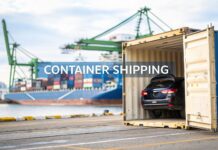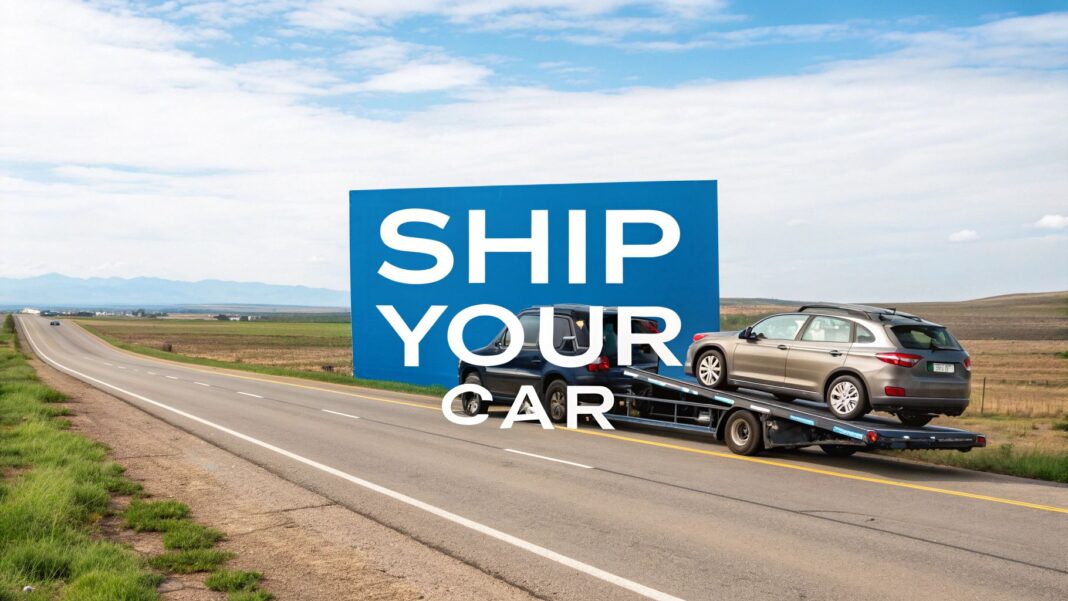
When you're shipping a car cross-country, your first decision is between open transport and enclosed transport. This choice directly impacts your cost, timeline, and the level of protection your vehicle receives during transit. Understanding the practical differences is the first step toward a smooth process.
Choosing Your Car Shipping Method
Let's break down the actionable differences between open and enclosed auto transport. Each method serves a specific purpose, and matching the service to your vehicle and budget is crucial.
The vast majority of cars—over 90%—are moved on open carriers. These are the familiar multi-car, double-decker trucks common on highways. It's the industry standard for a clear reason: it's the most cost-effective option. This method is the practical choice for a daily driver, family SUV, or any standard vehicle. While the car is exposed to weather and road elements, it's the same exposure it would face if you were driving it the same distance.
On the other hand, enclosed transport provides a fully sealed environment for your vehicle, protecting it from road debris, weather, and dust. This is the recommended method for classic cars, high-end luxury models, or vehicles with custom paint that requires pristine condition upon arrival. You will pay a premium for this service, but for a high-value or sentimental vehicle, the added protection provides essential peace of mind.
A Closer Look at Open vs. Enclosed Transport
To make this actionable, consider this scenario: you're relocating and need to move a reliable Honda CR-V from Florida to California. Open transport is the logical, budget-friendly choice.
However, if you're sending a restored 1967 Ford Mustang to a car show, enclosed transport becomes a necessary investment to safeguard its condition and value.
This overview highlights the core differences you need to consider.
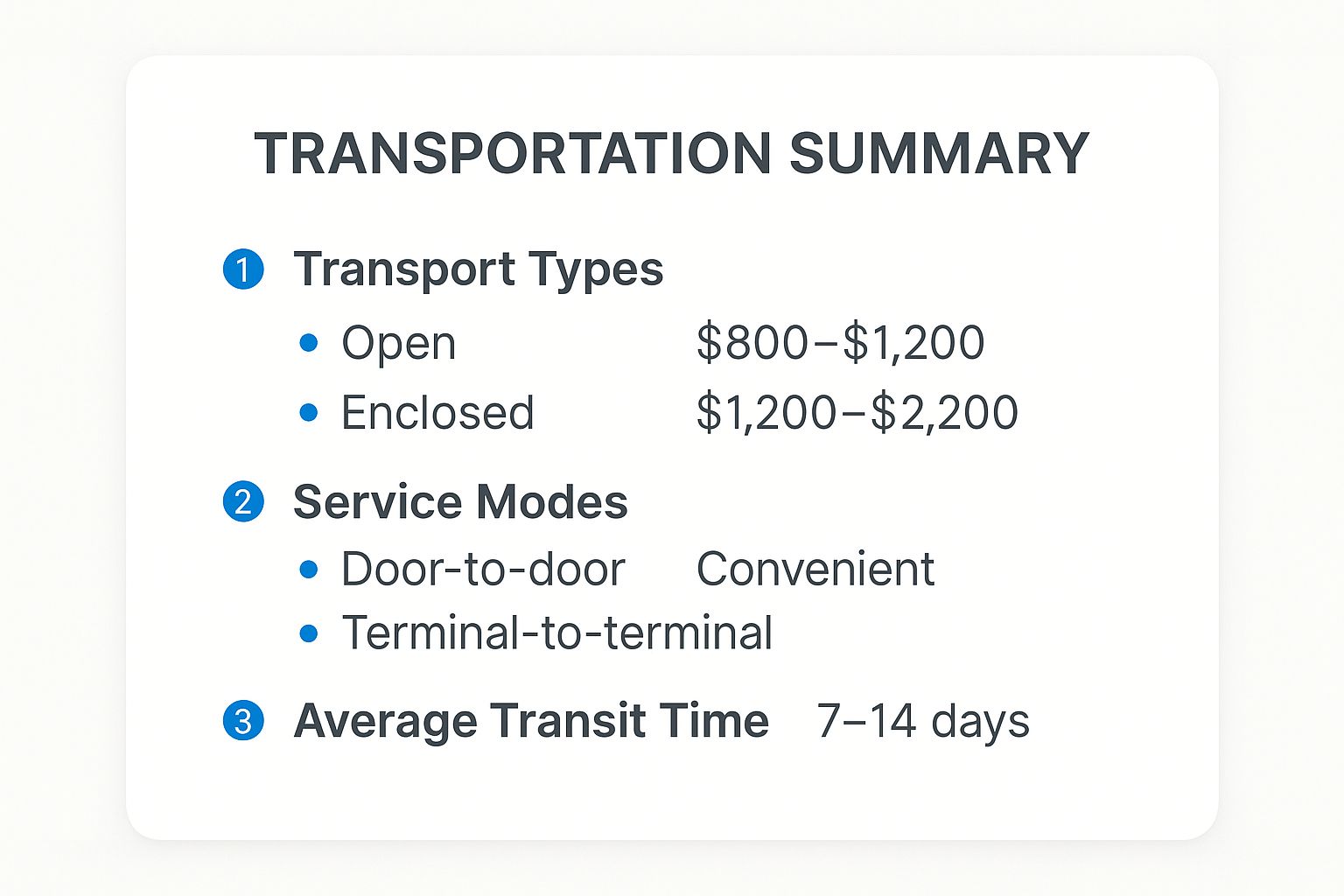
The primary trade-off is between cost and protection. Your decision here will set the foundation for your entire shipping plan.
To help you weigh the options, here’s a direct comparison of what each transport method offers.
Comparing Open vs Enclosed Car Transport
| Feature | Open Transport | Enclosed Transport |
|---|---|---|
| Cost | More affordable, budget-friendly | Higher price, premium service |
| Protection | Exposed to weather & road debris | Fully protected from all elements |
| Best For | Daily drivers, used cars, SUVs | Classic, luxury, exotic & custom cars |
| Availability | Widely available, more frequent routes | Less common, may require more scheduling flexibility |
| Capacity | Can carry up to 10 vehicles at once | Typically carries 1-7 vehicles |
Ultimately, choosing the right method is about more than the price. It’s about assessing the value of your vehicle and your tolerance for risk to find the right service for your specific needs.
More Service Options to Consider
Beyond the truck type, you must also choose between door-to-door and terminal-to-terminal service.
- Door-to-Door: This is the most convenient option. The driver picks up and delivers your vehicle as close to your specified address as is legally and safely possible.
- Terminal-to-Terminal: With this service, you drop your car off at a designated storage facility and pick it up from another at your destination. This can sometimes offer minor cost savings but requires you to manage the logistics of drop-off and pickup.
The right method isn't just about price—it’s about matching the service to your vehicle's value and your personal convenience needs. A little research upfront can prevent major headaches later.
Navigating these options is easier with a reliable partner. To learn what to look for in a company, this guide on how to find a good car shipping service offers actionable tips for vetting carriers.
How Car Shipping Costs and Timelines Actually Work
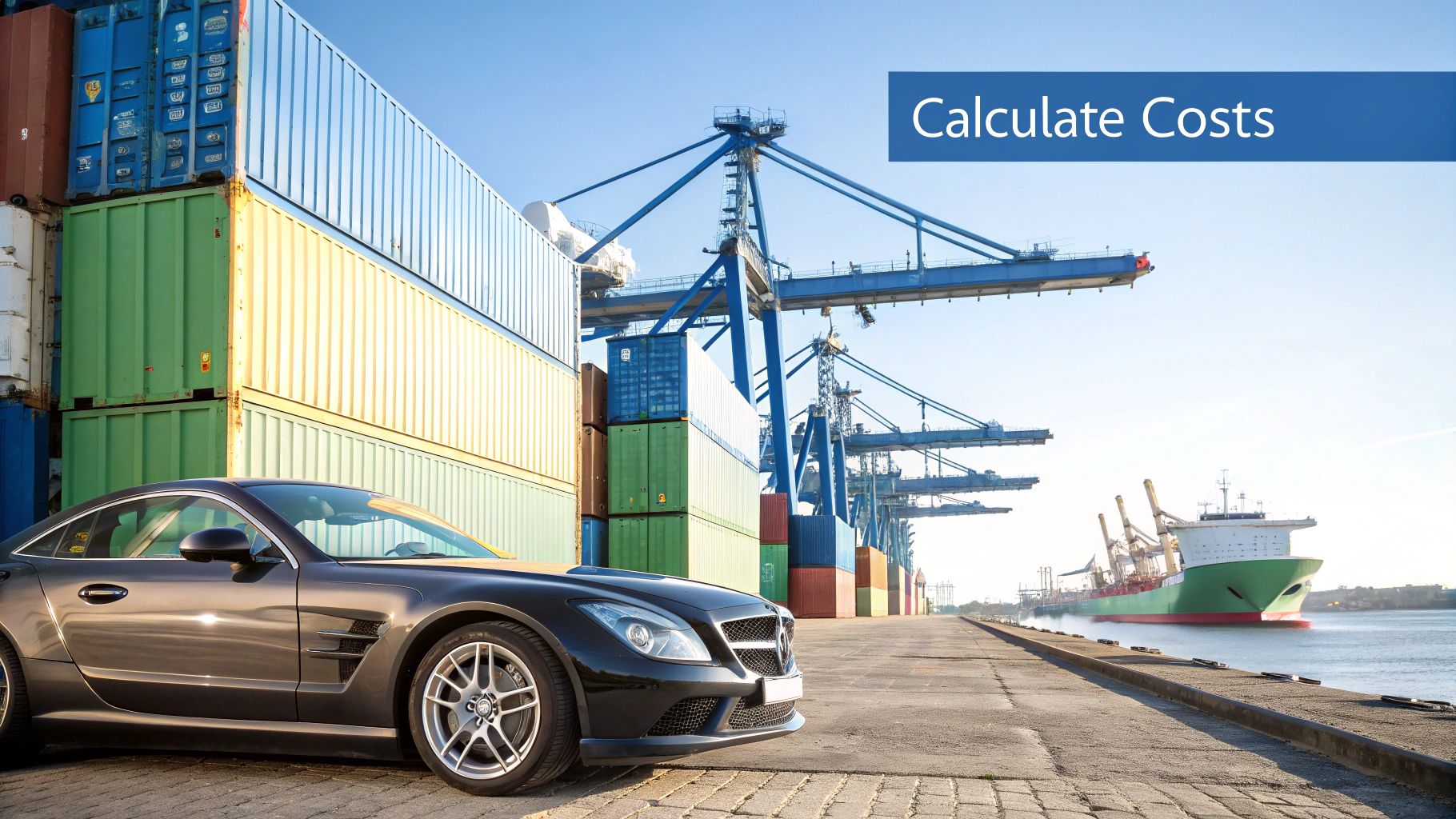
When you plan to ship a car across the country, two practical questions are paramount: what is the real cost, and how long will it take? While online calculators provide estimates, the final price is determined by several key variables. Understanding these factors will help you set a realistic budget and avoid unexpected charges.
The single biggest factor influencing the price is your route. High-traffic routes between major cities, like Los Angeles to New York, have more carrier competition, which typically lowers the price. Conversely, shipping to or from a remote, rural location requires the driver to deviate from standard routes, and the extra mileage and time will increase your quote.
Key Factors That Shape Your Quote
Beyond the route, a few other key details directly influence your final cost. The size and weight of your vehicle are major considerations. A Ford F-150 occupies significantly more space and weight capacity on a trailer than a Honda Civic, so it will cost more to ship.
Here are the primary factors that determine your quote:
- Vehicle Size: Larger vehicles like trucks and SUVs reduce the number of cars a carrier can transport, so you pay a premium for the extra space they consume.
- Transport Type: As discussed, selecting an enclosed trailer for maximum protection will be more expensive than a standard open carrier.
- Seasonality: Demand for car shipping peaks in the summer and around major holidays. If your schedule is flexible, shipping during the off-season (like January or February) can often result in lower rates.
Another way to potentially reduce costs is by choosing terminal-to-terminal service. While less convenient than door-to-door, dropping off and picking up your car from a carrier's designated lot can sometimes yield savings if a terminal is conveniently located for you. To see how these variables affect real-world pricing, explore our guide on the cost to ship a car.
Setting Realistic Timelines
It's important to understand that shipping a car is not a direct A-to-B drive. A cross-country journey of 2,500+ miles is a complex logistical operation.
Remember, that truck driver is juggling up to nine other vehicles. Each one has its own pickup and delivery window. Your car's journey is just one piece of a much larger, carefully planned route that has to factor in all those stops, mandatory driver rest breaks, and unexpected delays.
Due to these factors, a typical coast-to-coast shipment takes between 7 and 10 days. The average cost for shipping a standard sedan on such a route is approximately $1,150, but this can fluctuate based on fuel prices and seasonal demand. Acknowledging these operational realities helps you plan effectively and sets clear expectations for the entire process.
Preparing Your Vehicle for a Safe Journey
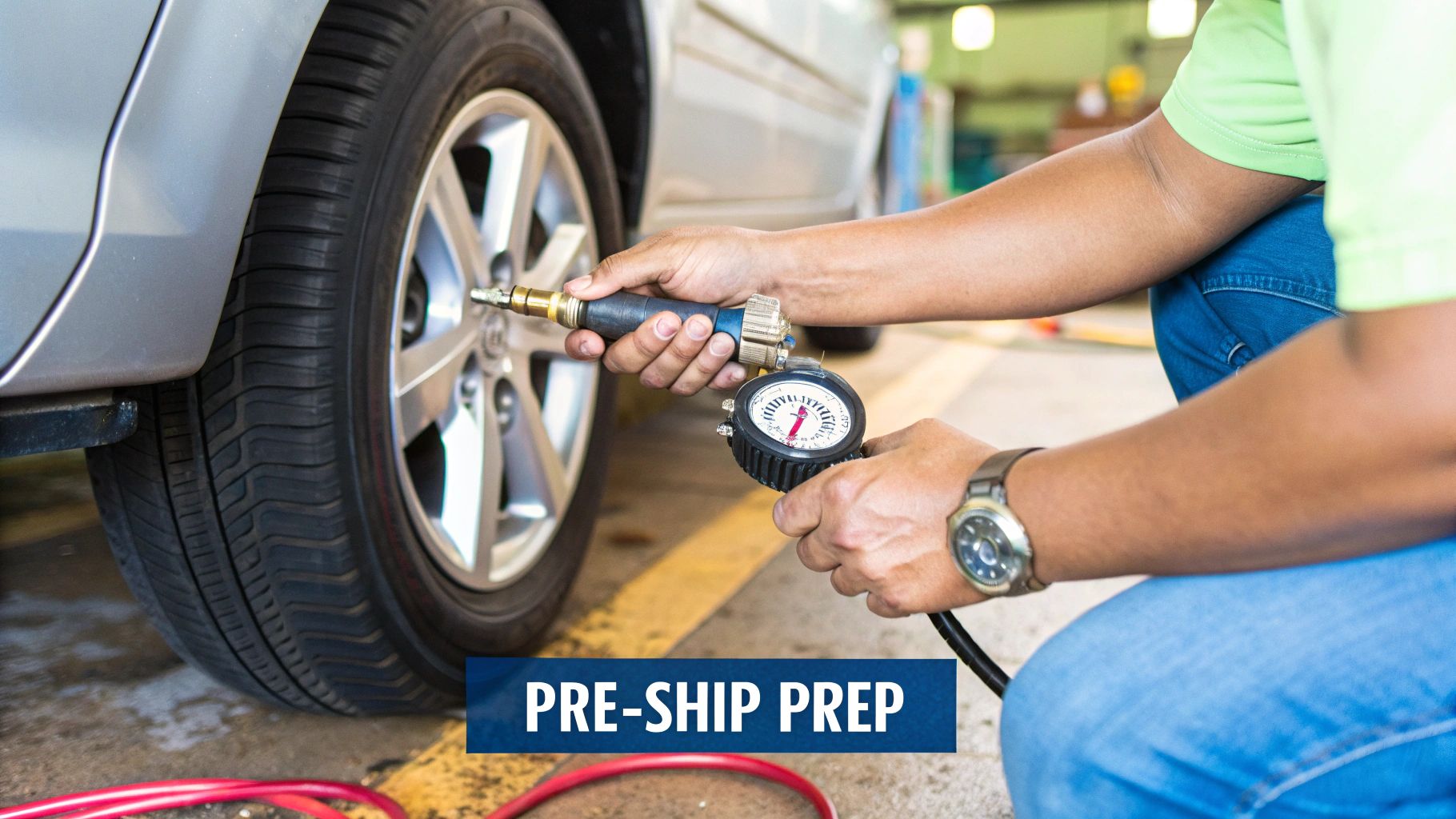
Properly preparing your car is a critical step to ensure a smooth, damage-free transport experience. This proactive work protects your vehicle and prevents potential delays or disputes.
First, wash your car thoroughly. This simple action is crucial because a clean surface allows you and the driver to perform an accurate pre-transport inspection. Every existing scratch, ding, and scuff must be identified and documented on the Bill of Lading (BOL)—the official condition report. This document is your primary evidence should a damage claim be necessary.
Document Everything Meticulously
Use your smartphone to create a detailed visual record before the carrier arrives. Take clear, timestamped photos and videos of your car from all angles, including the interior. Make sure to capture close-up shots of any pre-existing damage, no matter how minor.
This personal documentation serves as your independent proof of the vehicle's condition before it was loaded onto the trailer.
Your documentation is your power. Having clear, dated evidence of your car's pre-shipment condition can resolve any potential disputes quickly and fairly upon delivery.
Many vehicle preparation steps are similar to getting ready for a long road trip. For additional readiness tips, you can review this comprehensive guide for preparing a car for a long journey.
The Bill of Lading is a legally binding document that functions as both a receipt and a transport contract. You and the driver will sign it to agree on the vehicle's condition at pickup. Do not sign the BOL until you are fully satisfied with its accuracy.
Final Checks Before Handover
Before handing over your keys, complete a final checklist. These steps minimize risks and make the process of shipping a car across country smoother for both you and the carrier.
- Remove All Personal Items: This is a non-negotiable rule. Carrier insurance does not cover personal belongings left in the vehicle. Remove all loose items, including electronics, clothing, and documents.
- Leave a Quarter Tank of Fuel: A full tank adds unnecessary weight. The vehicle only needs enough fuel to be driven onto and off the carrier. The industry standard is a maximum of one-quarter tank.
- Secure Loose Parts: Fold in side mirrors and retract antennas. If you have removable custom parts like spoilers or roof racks, it is best to remove them before pickup.
- Disable Alarms and Toll Passes: Ensure your car alarm is disabled to prevent it from going off during transit. Deactivate any electronic toll passes to avoid incurring charges as the truck passes through toll points.
Navigating the Pickup and Delivery Process
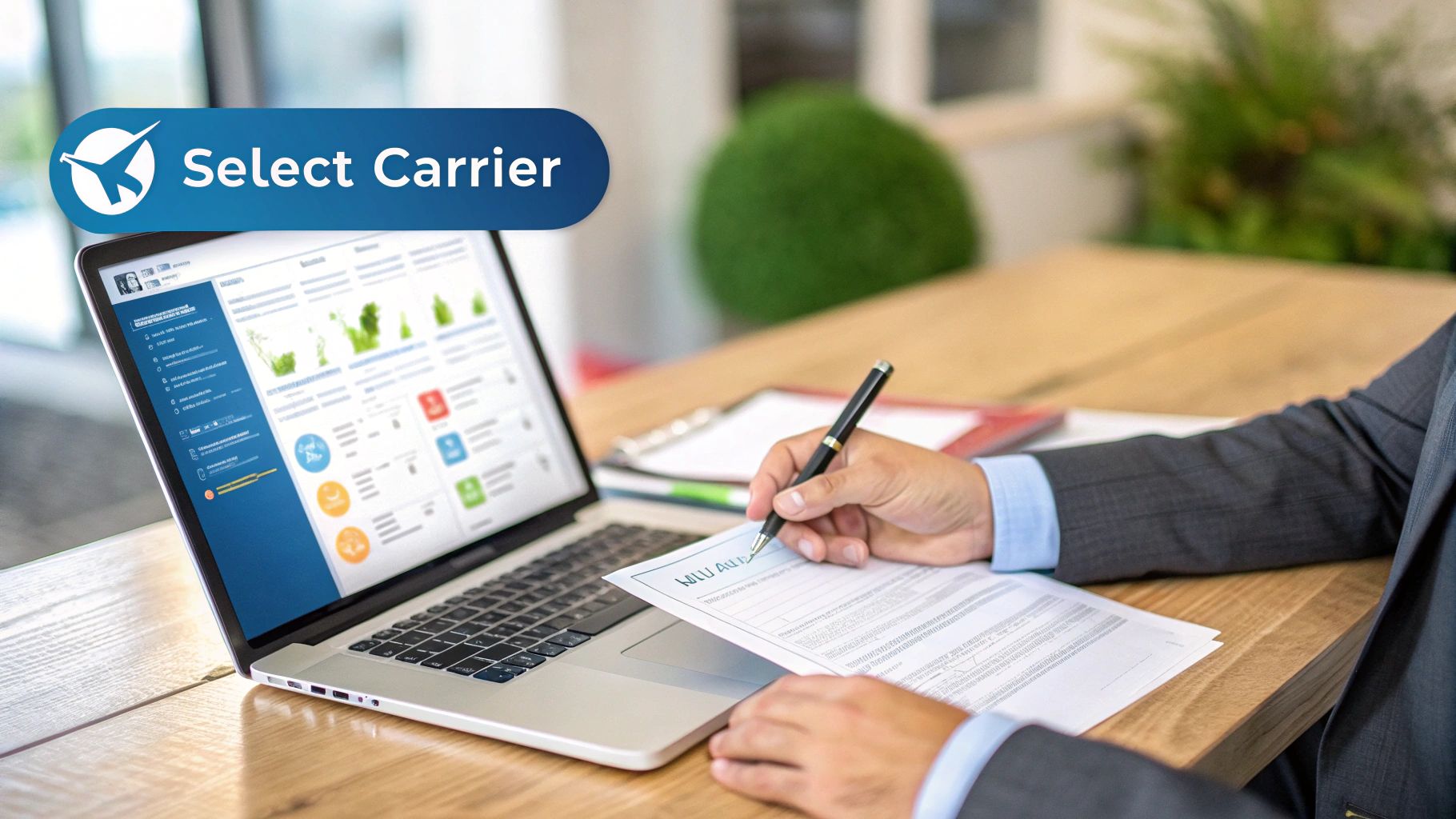
The pickup and delivery days are the most critical points of the shipping process. Knowing what to do and what to expect transforms a potentially stressful event into a professional and efficient transaction.
The single most important document is the Bill of Lading (BOL). It serves as a legal contract that details the terms of transport and, most importantly, documents the exact condition of your car at the moment of pickup.
The All-Important Vehicle Inspection
Before your car is loaded, you will conduct a joint inspection with the driver. Walk around the vehicle together and identify all pre-existing damage. Every scratch, ding, or scuff must be noted on the BOL.
The driver’s copy of the BOL includes a vehicle diagram where you will both mark the location and type of any imperfections. Do not rush this step. Your signature on the BOL signifies your agreement on the vehicle's initial condition.
A detailed and accurate Bill of Lading is your best friend if you need to file a damage claim later. Your signature confirms you agree with that initial report, so take your time and be thorough.
You will repeat this inspection process upon delivery to confirm that no new damage occurred during transit. A carefully completed BOL protects both you and the carrier.
Understanding Pickup and Delivery Logistics
While "door-to-door" service is the standard, the "door" is often a flexible term. Auto transport carriers are massive vehicles, often up to 80 feet long and weighing 80 tons. Their size makes navigating tight residential streets, cul-de-sacs, or areas with low-hanging trees impossible. This is a common logistical constraint in cross-country auto transport. You can get more insights on this from these 2025 car shipping trends on Montway.com.
As a result, you may need to arrange a nearby, accessible meeting point with the driver. Common and practical alternatives include:
- Large Parking Lots: Shopping centers, big-box stores, or parks provide ample space for the truck to maneuver safely.
- Wider Main Streets: The driver might request to meet on a major nearby road that can accommodate the truck without obstructing traffic.
- Your Workplace: An office with a large, accessible parking lot can serve as an ideal meeting spot.
This is not a sign of poor service but a necessary adjustment for safety and practicality. Maintaining open communication with your driver is key to arranging a convenient meeting place and ensuring the process of shipping a car across country is seamless. Upon delivery, you'll perform the final inspection, sign the BOL to accept the vehicle, and receive your keys.
Understanding Insurance Coverage and Tracking
Knowing your vehicle is protected and trackable provides crucial peace of mind during transit. Understanding how carrier insurance works and what tracking options are available is a critical part of the shipping process.
Every licensed auto transport carrier is required to have insurance. It's important to know that the carrier's cargo policy is the primary coverage for your vehicle while it is in their possession. Your personal auto insurance policy typically does not cover commercial transport, so you cannot rely on it as a backup.
Clarifying Carrier Insurance Details
Before committing to a service, you must verify the carrier's insurance. Request a copy of their Certificate of Insurance. This document confirms that their policy is active and specifies their coverage limits.
One critical detail to confirm is the deductible. In some cases, a carrier's policy may have a high deductible, which the customer could be responsible for in the event of a claim. Clarifying this upfront prevents unexpected costs later. For a complete overview, you can read this guide on how auto shipping insurance works.
Pro Tip: Ask your shipping coordinator point-blank: "What's your carrier's deductible, and who pays it if there's a claim?" A transparent company will give you a straight answer without hesitation.
Staying Informed with Vehicle Tracking
Once your car is en route, you will want updates on its location. Tracking methods vary between companies, but here are the most common ways to monitor your vehicle's journey:
- GPS Links: Some modern carriers offer a direct GPS tracking link for their trucks, providing real-time location data.
- Direct Driver Communication: The most common method involves direct contact with the driver via phone or text for periodic updates.
- Dispatch Updates: You can also call the company's central dispatch office, which will then contact the driver and relay the vehicle's location to you.
It's also worth noting that the high volume of standard vehicles being shipped has made logistics and tracking a more streamlined, expected part of the service. A recent analysis of over 5,000 shipments found that roughly 75% of cars transported are common models like Toyotas and Fords, with only 25% being luxury vehicles. This constant movement on popular routes has improved operational efficiency.
Confirming robust insurance coverage and clear tracking procedures are essential steps for a stress-free experience when shipping a car across country.
Got Questions? We've Got Answers
https://www.youtube.com/embed/CgFgD3Xxwwc
Even with careful planning, questions often arise. Here are direct answers to the most common inquiries to help you feel confident about your vehicle's transport.
So, Can I Pack My Car Full of Stuff?
This is the most frequently asked question, and the answer is a firm no. Loading your car with personal items is prohibited for several important reasons.
First, the carrier's insurance covers only the vehicle itself, not its contents. If your items are lost, damaged, or stolen, you have no recourse for a claim.
Second, transport companies are licensed to carry vehicles, not household goods. They face significant fines from the Department of Transportation if caught transporting personal belongings. Added weight can also push the truck over its legal limit, resulting in fees or the driver's refusal to load your car. It is best to ship personal items separately, leaving only standard vehicle accessories like a spare tire and jack inside.
What If My Car Gets Damaged in Transit?
While rare, damage can occur. If your vehicle arrives with new damage, there is a clear process to follow, but it hinges on one critical action.
During the final delivery inspection with the driver, you must note any new damage on the Bill of Lading (BOL) before you sign it. This step is non-negotiable.
Use your phone to take clear photos of the new damage, ideally with the driver present, to create a timestamped visual record. After the damage is noted on the BOL, contact the shipping company immediately to initiate the claims process.
Your notes on the Bill of Lading are your official proof that the damage happened while the carrier had your car. Without that documentation, proving your claim becomes a massive uphill battle.
The carrier's cargo insurance exists for this purpose, and your thorough inspection and documentation are what make the claims system work effectively.
How Far in Advance Should I Book My Shipment?
For the best balance of price and carrier availability, book your auto transport two to four weeks in advance. This timeframe allows the broker or carrier ample time to schedule a truck for your route, which typically results in a better rate.
Booking early is especially important during peak seasons, such as summer and around major holidays. While last-minute shipping is often possible, it usually comes at a premium due to limited truck availability on short notice.
Do I Really Need to Be There for Pickup and Delivery?
Yes, absolutely. Either you or a trusted representative (over the age of 18) must be present for both pickup and delivery. This person's role is crucial.
They are responsible for:
- Conducting the vehicle inspection with the driver before loading and after unloading.
- Signing the Bill of Lading (BOL) to confirm the vehicle's condition at both points.
- Handing the keys to the driver at pickup and receiving them at delivery.
This ensures that all parties agree on the vehicle's condition throughout the entire transport process, protecting you from potential disputes.
When you're ready to take the next step, let the experts at We Will Transport It handle the details. We provide transparent pricing and reliable service to ensure your vehicle arrives safely and on time. Get your free, no-obligation quote today at https://www.wewilltransportit.com.




